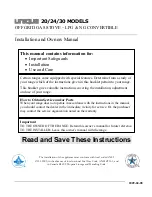
HEALTH & SAFETY PRECAUTIONS
I
Please take care when installing the stove that the requirements of
the Health and Safety at Work Act 1974 are met.
Some types of fire cement are caustic and should not be allowed to
come into contact with the skin. In case of contact wash with plenty
of water.
If there is a possibility of disturbing any asbestos in the course of
installation then please use appropriate protective equipment.
There must not be an extractor fan fitted in the same room as the
stove as this can cause the appliance to emit fumes into the room.
There must be an adequate air supply into the room in which the
appliance is installed to provide combustion air. There is no statutory
requirement for air supply for a stove less than 5kW, but to avoid
unwanted drafts,
the external air supply kit is available from
Charnwood as an optional extra.
In addition to these instructions the requirements of BS.8303 and BS
EN 15287-1: 2007 must be fulfilled. Local Authority Bylaws and
Building Regulations regarding the installation of Solid Fuel burning
appliances, flues and chimneys must also be observed, including those
referring to national and European Standards.
CO Alarms
Building regulations require that when ever a new or replacement
fixed solid fuel or wood/biomass appliance is installed in a dwelling a
carbon monoxide alarm must be fitted in the same room as the
appliance. Further guidance on the installation of the carbon
monoxide alarm is available in BS EN 50292:2002 and from the
alarm manufacturer's instructions. Provision of an alarm must not be
considered a substitute for either installing the appliance correctly or
ensuring regular servicing and maintenance of the appliance and
chimney system.
CHIMNEY
HEARTH AND FIRE SURROUND
The stove must stand on a fireproof hearth and must be situated at
least the following distances from any combustible material:
In order for the appliance to perform satisfactorily the chimney height
must not be less than 4 metres measured vertically from the outlet of
the stove to the top of the chimney. The minimum internal chimney
size is 125mm diameter (5 inches) or 125mm x 125mm.
These stoves are NOT to be used in a shared flue. If an existing
chimney is to be used it must be swept and checked, it must be in
good condition, free from cracks and blockages, and should not have
an excessive cross sectional area. If you find that the chimney is in
poor condition then expert advice should be sought regarding the
necessity of having the chimney lined. If it is found necessary to line
the chimney then a lining suitable for Solid Fuel must be used.
If there is no existing chimney then a prefabricated block chimney or
a twin walled insulated stainless steel flue to BS EN 15287-1: 2007
can be used either internally or externally. These chimneys must be
fitted in accordance with the manufacturers instructions and Building
Regulations.
Anki pumice liners or chimney blocks will give a highly insulated
chimney which will work well with all fuels. For details ring Anki
Chimney Systems on (01983) 527997.
Single wall flue pipe of minimum diameter 125mm is suitable for
connecting the stove to the chimney but is not suitable for using for
the complete chimney.
If it is found that there is excessive draw in the chimney then a
draught stabilizer should be fitted.
It is important that there is sufficient draw in the chimney and that
the chimney does not suffer from down-draught. When the chimney
is warm the draw should be not less than 25pa (0.1 inches water
gauge). If in doubt about the chimney seek expert advice.
Side
550mm (22in)
Back
550mm (22in)
The hearth must be at least 12mm (0.5inches) thick. The positioning
of the stove and the size of the hearth are governed by building
regulations for Class 1 appliances. These building regulations state
that the hearth must extend in front of the stove by at least 300mm
(12 inches) and to the sides of the stove by at least 150mm (6
Output
Weight Low Stand
Store Stand
Centre Stand
Flue Gas Temp.
Flue Gas Mass Flow
Min Flue Draught
(warm flue)
Max Hearth Temp.
4.0kw
89 kg
96 kg
104 kg
248°C
3.9g/s
25 Pa
(0.1in wg)
(13,650 Btu/h)
39°C
The outputs were obtained burning seasoned hardwood over a 0.8
hourly re-fuelling cycle.
9
®
INSTALLATION INSTRUCTIONS
charnwood
SPECIFICATION


































